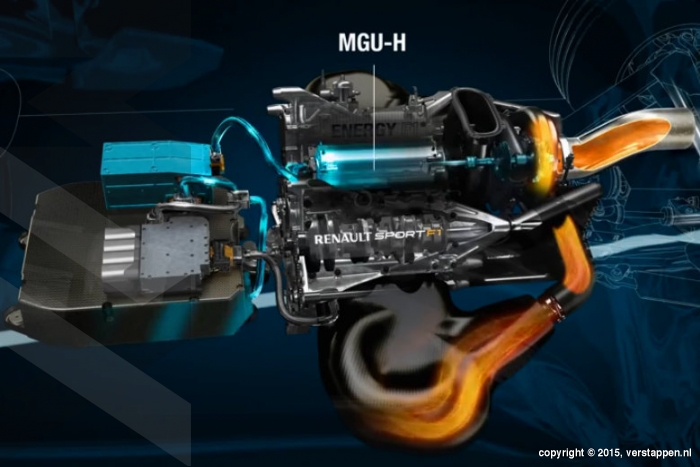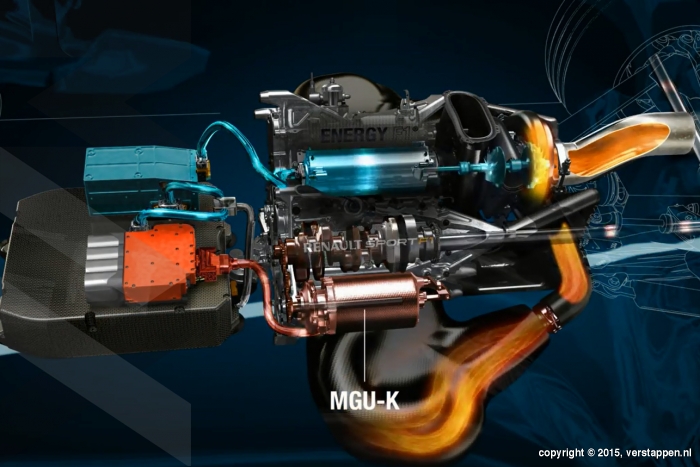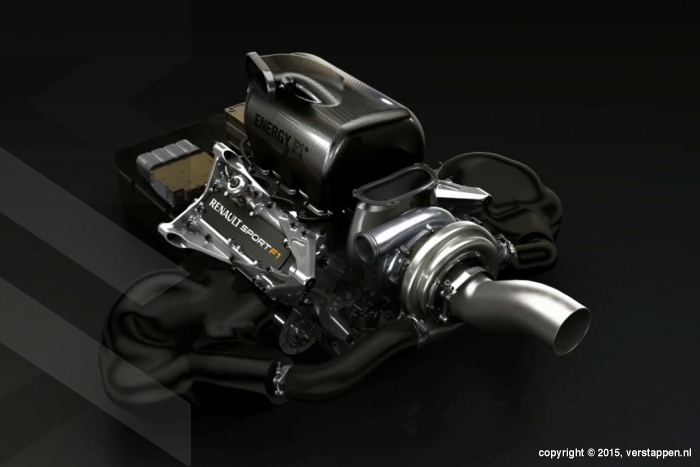Formula 1-engine explained
Published on 23 April 2015 by Mike Motilall
Lately there has been much ado about the Renault engine with which the Formula 1-car of Max Verstappen (as well as some others) is powered with. A broken spark plug stopped the youngster, in this year’s first race in Australia, to finish in the top ten. In China, a guaranteed eighth spot, literally went up in smoke three laps before the checkered flag.
For the qualification of the fourth race of this season in Bahrain, for the second time, a new engine was bolted on the STR10. With that it seemed no question that Max would finish the season without any grid penalties. The rules clearly state that a driver loses ten grid positions every time an additional power unit is used.
Renault has worked hard during the winter to make up for the backlog they have on Mercedes. They have only partly succeeded. The progress achieved in gain of power has also brought some reliability issues, with which predominantly Max, and to some extent Daniil Kvyat, has had to deal with in previous races. In Bahrain, Max suffered from electrical problems, that forced him to prematurely pit his Toro Rosso. Daniel Ricciardo also had issues with his power unit. Red Bull’s always smiling Aussie, was barely able to finish the race when his engine popped some few hundred yards before the finish line.
Rob White, Technical Director at Renault F1 Sport, announced on the eve of the Bahrain GP, that the previous issues were likely to occur again in Bahrain. “The problem with Kvyat’s engine was unknown to us and I reckon that we dealt with it adequately. The issue with Max’ power unit, is another story. We don’t have an adequate solution for that at this moment.”
“We are still behind on schedule to solve the previous problems. In Australia we had problems with the drivability of the engines, these issues were solved and we hope that from Monaco onwards we will be looking better. Regarding power, there are still updates to be expected later on during this season,” White relays.
 Since the beginning of the previous season, the current engine regulations are in place regarding the use of the 1.6 liter V6 combustion engine. These engines are linked to powerful systems that recover energy. Two MGU's, meaning: Motor Generator Units, win back energy from the hot exhaust gasses and during braking. Apart from that, these units are also capable of acting as electric motors.
Since the beginning of the previous season, the current engine regulations are in place regarding the use of the 1.6 liter V6 combustion engine. These engines are linked to powerful systems that recover energy. Two MGU's, meaning: Motor Generator Units, win back energy from the hot exhaust gasses and during braking. Apart from that, these units are also capable of acting as electric motors.
Both MGU’s are linked to the turbocharged engine, and has been fitted as compact as possible in the car. During acceleration of a Formula 1-car, the turbo charger is performing at its peak and is spinning at about 100,000 rpm. The MGU-H (Heat) functions at that moment as a generator. This is connected to the turbo charger and converts the energy, generated by the turbo, into electricity; that, in turn, is stored in a battery or sent directly to the MGU-K.
 This MGU-K (Kinetic), connected straight to the crankshaft of the turbo engine, acts as an electric motor that supplies extra power to said engine. This MGU changes into a dynamo, which stores the energy that is released during braking in the battery. This stored energy, can later be used to support the turbo engine during acceleration or over taking.
This MGU-K (Kinetic), connected straight to the crankshaft of the turbo engine, acts as an electric motor that supplies extra power to said engine. This MGU changes into a dynamo, which stores the energy that is released during braking in the battery. This stored energy, can later be used to support the turbo engine during acceleration or over taking.
After hard braking, the engine rpm drop as so does the rpm of the turbo. In order to avoid the so called “turbo lag”, the MGU-H is used to keep the turbo charger running at the appropriate speed. All these complex systems are working closely together by means of electric control units, that are operated by the driver to a certain extent, enabling them to somewhat adapt their strategy. They also have the means to shortly increase their power to assist them when overtaking another driver or, alternatively, avoid being overtaken by an opponent.
 With the connection of these hybrid systems, together with the limited fuel quantity and fuel flow rate, one of the most efficient power unites ever built, emerges. During racing season 2014, teams were allowed to use only five of these units. This season that number has dropped to just four.
With the connection of these hybrid systems, together with the limited fuel quantity and fuel flow rate, one of the most efficient power unites ever built, emerges. During racing season 2014, teams were allowed to use only five of these units. This season that number has dropped to just four.
With just eighteen days remaining, before the first session in Spain, Renault is going to need more time to come up with more permanent solutions. Solutions that will enable performance the way Renault, Scuderia Toro Rosso and Red Bull Racing would like to see.
The most important specs of the current F1-power unit:
- 1.6 liter V6 turbo charged engine
- Maximum engine speed: 15.000 revs/minute
- Power unit outfitted with 2 MGU’s
- Combined maximum power output: ca. 850 Bhp
- Fuel consumption maximum 100 kg./race
- Fuel flow rate maximum 100 kg./hr
- Maximum 4 power units per year per driver



